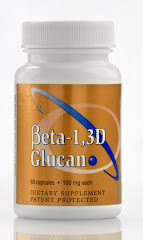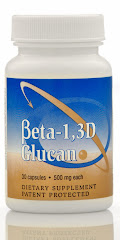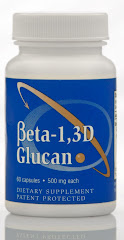The Immune Response Enhanced by Beta-1,3D Glucan by A.J.Lanigan - pg.3
When a Class II MHC molecule is presented by the APC, the B cell/antibody process begins. This is the humoral side of the immune system. The antibodies released by the B cells bind to antigens on the surfaces of free-floating viruses. Besides making it easier for macrophages to destroy viruses, this binding signals blood components called complement to puncture holes in the viruses. The Complement System is made up of 25 proteins that work with the antibodies to destroy invaders. They facilitate phagocytosis (eating by phagocytes) or they directly puncture the invader's cell membrane. C3 is the key protein that triggers the "complement cascade". This cascade results into a "membrane attack complex" that literally blasts a hole into the antibody marked prey. Fragments thrown off by this process bring into play mast cells and basophils. By releasing their chemical contents, they produce the rediness, warmth, and swelling of the inflammatory response.
Finally, as the infection is brought under control, the activated T and B cells are turned off by suppressor T cells (a T-8 subset). However, a few "memory cells" (another T-8 subset) remain behind to respond quickly if the same virus attacks again. Immunologists believe that the body fights cancer in much the same way it seeks to eliminate viruses. Further study of the immune system is expected to reveal ways to bolster it, allowing the body to become a more active partner in the fight against cancer. - source
Transfer Point Beta Glucan # 300, Scientifically Proven to be The Ultimate in Beta Glucans
Contact:
Healthful Links
Labels
- 3-D Glucan (1)
- 3D Glucan (1)
- A.J. Lanigan (3)
- aging (1)
- allergies (3)
- Alveolar cells (1)
- Analysis (1)
- Animals (2)
- anthrax research (1)
- anthrax spores (1)
- antibody formation (1)
- antigens (3)
- APC (1)
- ash levels (1)
- athletes (1)
- Auburn University (1)
- Authorized Distributor of Transfer Point Beta Glucan (1)
- autoimmune (1)
- Autoimmune Disease (2)
- B cells (2)
- bakers yeast (8)
- BakersYeastBetaGlucan (5)
- barley (1)
- basophils (1)
- Best Beta Glucan (1)
- Beta Bitts (2)
- Beta Glucan (15)
- Beta Glucan Anti Stress Report (1)
- Beta Glucan Research (1)
- Beta Glucan sources (1)
- beta glucan technology (1)
- Beta Glucan: Nature's Secret (1)
- Biological response modifiers (1)
- bone marrow (2)
- Brain cells and tissue (1)
- brain imaging (1)
- breast cancer (1)
- C3 protein (1)
- cancer (4)
- cancer research (1)
- cardiovascular disease (1)
- cell wall of bakers yeast (1)
- Certificate of Analysis (2)
- chemotaxis (1)
- chemotherapy (2)
- chemotherapy recovery (1)
- Chi Machine (1)
- Cholesterol (1)
- cholesterol research (1)
- Chronic Stress (1)
- Class II MHC molecule (1)
- clinical trials (1)
- Common Cold (1)
- CoQ10 (1)
- corticosterone (1)
- CTLs (1)
- cytokine (5)
- cytotoxic T lymphocytes (1)
- Dosage (2)
- Dr. Jana Vetvickova (1)
- Dr. Vaclav Vetvicka (5)
- Endocytosis (1)
- Enterocytes (1)
- Enterones (1)
- eosenophils (1)
- FIR Dome (1)
- Flu (1)
- Gamma-Interferon (1)
- genetically engineered foods (1)
- Glucan (2)
- Glucan #300 (5)
- Glucan 300 (2)
- Glucan Research (1)
- Glucose molecules (1)
- grains (1)
- HealthIsInReach (1)
- hematopoiesis (1)
- hemotopoeisis (1)
- Homologous polysaccahides (1)
- hospital acquired infections (1)
- Human parainfluenza viruses (1)
- IL-1 (2)
- IL-2 (4)
- illness (1)
- immune cells (1)
- immune modulator (3)
- immune protection (1)
- immune response (5)
- immune stimulating component (1)
- immune supplement (1)
- Immune support (1)
- immune system (11)
- Immune System support (1)
- immuno-modulating properties (1)
- Immunologists (1)
- immunomodulator (1)
- infectious disease (1)
- infectious disease research (1)
- interleukin-1 (1)
- interleukin-2 (1)
- Journal of Medicinal Foods (1)
- Journal of the American Nutraceutical Association (1)
- LDL cholesterol (1)
- Long Chain Polysaccharide (2)
- Lymph nodes (1)
- Lymphatic System (1)
- Lymphoma (1)
- Macromolecules (1)
- macrophages (6)
- Major Histocompatibility Complex (2)
- mediated immune response (1)
- MHC (2)
- MHC I complex (1)
- Microglial cells (1)
- monoclonal antibody (1)
- mushrooms (1)
- myelosupression (1)
- natural alternatives (1)
- Natural Immunomodulators (1)
- natural killer cells (1)
- Neutrophil cells (1)
- neutrophils (2)
- New Book Release (1)
- NK cells (2)
- NPcaps (1)
- NPcaps capsules (1)
- Number one Beta Glucan (1)
- oat (1)
- Open Glycoscience (1)
- oral Beta glucan (1)
- Original Sun Ancon Chi Machine (1)
- patents (3)
- Pet (1)
- PET Scans (1)
- phagocytes (2)
- phagocytosis (4)
- Polysaccharides (1)
- Potency (1)
- Product line (1)
- Professor of Pathology (1)
- protein levels (1)
- Pullulan (1)
- radiation (1)
- radiation protective effect (1)
- radiation recovery (1)
- radiation research (1)
- Resveratrol (1)
- Retroperitoneal Lymph nodes (1)
- Saccharomyces cerevisiae (2)
- seaweed (1)
- Selenium (1)
- stem cells (1)
- stress (2)
- T cells (4)
- Th1 (1)
- Th2 (1)
- TNF (1)
- toxins (1)
- Transfer Point (11)
- Transfer Point Beta Bitts (1)
- Transfer Point Beta Glucan (14)
- Transfer Point Beta Glucan out performs the rest (1)
- Transfer Point Beta Glucan outperforms all other immune supplements tested (1)
- Transfer Point Beta Glucan Purity (2)
- Transfer Point Beta Glucan supplier (1)
- Transfer Point Beta-1 (1)
- tumor (1)
- universities (1)
- University of Louisville (2)
- viruses (1)
- What is Beta 1 (1)
- What is Beta Glucan? (1)
- white blood cells (1)
- Yeast beta glucan (2)
- Yeast cell walls (1)
These statements have not been evaluated by the Food and Drug Administration.
The information provided is not intended to diagnose, treat, cure or prevent any disease.
The information provided is not intended to diagnose, treat, cure or prevent any disease.



